
Pipes are invaluable conduits that carry water to and from your home. But when internal pipe damage occurs, it can disrupt this flow, potentially leaving you without water. As an expert in water line repair in Lincoln, CA, we advocate for homeowners to get acquainted with the causes of internal pipe damage as a preventive measure. Let’s dive into how corrosion, improper installation, high water pressure, and mineral buildup arise, the warning signs to watch for, and the steps to safeguard your pipes.
Corrosion: A Hidden Enemy
Pipes can degrade due to corrosion over time. This is especially true for metal pipes. Corrosion often stems from chemical reactions between the pipe material and the water flowing through it, particularly if the water is acidic or rich in oxygen.
Corroded pipes can cause discolored water, a metallic taste, or reduced water flow. “If you notice reddish or brownish water coming from your taps, it’s a telltale sign of pipe corrosion,” says a licensed plumber. Ignoring this can lead to leaks or pipe bursts, setting up a potential need for water line replacement.
Improper Installation: Setting the Stage for Failure
Pipes that are improperly installed create vulnerabilities in your plumbing system. Mistakes such as incorrect pipe sizing, loose connections, or inadequate support can result in leaks, pressure imbalances, and eventual damage. Unfortunately, these issues only surface when damage has escalated, meaning they may not be addressed as they occur.
If you suspect having a damaged water line, don’t wait. A professional inspection can identify and rectify the issue before it causes significant harm. Trusted plumbers can ensure your pipes are correctly installed, meeting local codes and standards for safety and efficiency.
The Impact of High Water Pressure
Strong water pressure devastates pipes. Excessive pressure stresses the internal structure of the pipes, leading to cracks, leaks, or even complete failure. High water pressure can also strain appliances such as dishwashers and washing machines, reducing their lifespan.
Most residential plumbing systems are designed to handle water pressure between 40 and 60 psi. If your pressure exceeds this range, a pressure regulator can complement a water line installation. “A pressure regulator is an inexpensive fix,” advises a plumbing expert. “It can save you thousands in potential damage.”
Mineral Buildup: The Silent Blockage
Hard water is another enemy of your plumbing system. This type of water contains high levels of minerals like calcium and magnesium. Over time, these minerals accumulate inside the pipes, narrowing the passageway and restricting water flow. This can lead to clogs, increased pressure, and eventual pipe damage.
Reduced water pressure, white or chalky residue around faucets, and a sluggish flow from taps are signs of mineral buildup that you should pay attention to. If you live in an area with hard water, consider installing a water softener to prevent these deposits from wreaking havoc on your plumbing system.
Signs of Internal Pipe Damage
Recognizing internal pipe damage can save you from costly repairs. Keep an eye out for:
- Discolored or murky water.
- Unexplained drops in water pressure.
- Odd noises like banging or gurgling from pipes.
- Persistent leaks or damp spots in walls and ceilings.
If any of these symptoms appear, it’s time to call a professional plumber. Don’t delay water pipe repair. It can exacerbate the damage and lead to more extensive—and expensive—issues.
Preventing Internal Pipe Damage
When it comes to your plumbing system, prevention of issues should be your priority. Installing pressure regulators, water softeners, and high-quality pipe materials are some of the most effective ways to protect your pipes. Modern materials like PEX or PVC are durable, corrosion-resistant, and better suited to handle the demands of today’s households.
Routine maintenance is equally important. Schedule annual plumbing inspections to identify and address small problems before they escalate. Professionals can also flush your pipes to remove mineral deposits and inspect for signs of corrosion or wear. In industrial and municipal systems, pigging services are often used for similar maintenance tasks to keep pipelines clear and functioning efficiently
The Risks of Ignoring Pipe Damage
Whether dealing with a minor leak or a major burst, remember that neglecting internal pipe damage can lead to severe consequences. With flooding as an obvious outcome, water damage can also occur, encouraging mold growth and posing health risks to your family.
Understanding corrosion, improper installation, high water pressure, and mineral buildup can empower you to seek bold solutions when faced with pipe damage. Remember, recognizing the warning signs and investing in professional services is key. Doing these can keep your plumbing safe for use, efficient, and reliable.
